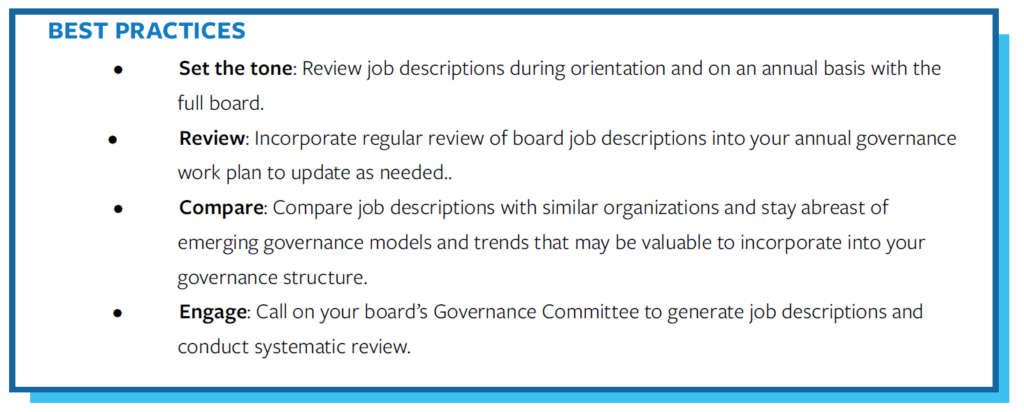
When a new trustee joins your board, or if a board member is assuming a new role, it is imperative to establish clear expectations for their roles and responsibilities. A comprehensive description of each board position is fundamental in fostering a successful board by clarifying individual and collective duties, thereby reducing ambiguity and potential conflicts. The CEO or a designated board member should engage in discussions regarding job descriptions during the recruitment and orientation processes or when onboarding a new officer or committee position.
Job descriptions also serve as a framework for holding board members accountable for their contributions. Well-defined expectations facilitate the assessment of individual and overall board performance.
The officer positions on a board of trustees typically include:
- Chairperson
- Vice-chairperson
- Secretary
- Treasurer
- At-large or general board member
Sample job descriptions may be outlined as follows:
Board Chair – As the leader of the board, the Chair works closely with the CEO to manage board affairs effectively. The board chair assumes leadership responsibilities, setting the agenda and priorities for board meetings, ensuring smooth facilitation, and promoting efficient and professional board operations. The chair plays a critical role in overseeing the decision-making process and policy adherence. Additionally, the chair appoints committee chairs and collaborates with the chief executive in recommending committee members. The chair also contributes to recruitment, orientation, and CEO evaluations.
Vice Chair (also known as Chair-Elect) – As the vice-chair, this role entails understanding the responsibilities of the board chair in order to fulfill them in their absence. The vice-chair actively participates in board leadership and undertakes special assignments as needed.
Secretary – The role of the board secretary is pivotal in maintaining administrative and record-keeping functions within a board of directors or a governing board of an organization. The secretary assumes responsibility for meeting minutes, notices, agendas, and documentation of board actions. These duties enable the board to function effectively, meet regulatory requirements, and maintain a historical record of the organization’s decision-making and actions.
Treasurer – This role serves as the chair of the finance committee. The treasurer oversees the organization’s finances, including budget organization, and typically leads the board’s finance committee. They work closely with the CEO and CFO to ensure the availability and comprehensibility of financials and reports. Additionally, they review the annual budget and audit.
General or At-Large Trustee – The role of a general trustee encompasses attending meetings and functions, having a thorough understanding of the organization’s mission, reviewing materials, serving on committees, making donations, advocating for the organization, suggesting nominees, representing the organization, adhering to policies, refraining from special requests, and assisting with fiduciary responsibilities.
Written job descriptions for the board of directors are indispensable in establishing a well-functioning and accountable board. Clearly defined job descriptions enable current board members to comprehend their duties and facilitate succession planning by identifying the skills and attributes required for future board members. These descriptions provide clarity, guide recruitment and orientation processes, promote effective governance, and contribute to the organization’s overall success. Boards or a designated committee should regularly review job descriptions to ensure they encompass the appropriate responsibilities, align with the organization’s needs, and remain relevant in the current health care environment.

